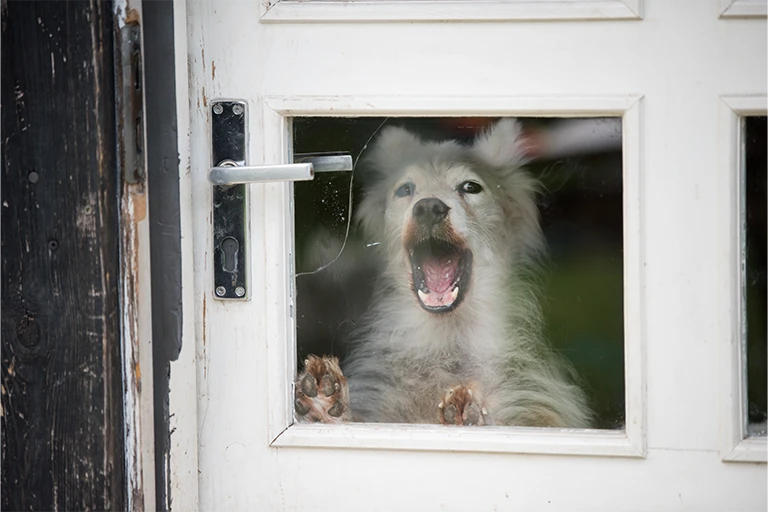Dog won’t stop barking?
You’re not alone.
Barking driving you (and the neighbors) crazy?
Good news: We’ve got fixes. Simple steps to turn down the noise.
Stick around. Let’s get that peace back, step by step.
Recognizing Why Dogs Bark Excessively
Ever wonder why your dog barks so much?
It’s like a language, and each bark tells its own tale.
Unlocking these barking codes can elevate your bond with your pup and turn down the volume on that excessive noise.
The heart of any problem is its cause. With barking, it’s no different. Dive into the nuances of each bark and get to the root, not just the noise.
Some barks are chirpy tunes of joy, others, long cries of loneliness. Tune into the bark. Decode these differences, linking them to what’s happening around your dog.
When does the barking spike? A stranger at the door? Playtime? Or those lonely moments when you’re away? Zero in on these triggers.
It might sound overboard, but jotting down barking episodes can uncover behavior trends. Note the when, why, and how long – the patterns you find could be game-changing.
Loop in the experts. A vet can ensure there’s no medical hiccup causing the bark frenzy.
By cracking your dog’s bark code, you’re not just quieting the noise, but also tuning into your pet’s feelings.
Training Techniques to Control Excessive Barking

Want a quieter, more attentive pup? The right training can make your dog not just listen more, but bond deeper with you.
Remember, training isn’t just about silencing barks—it’s about building understanding and harmony between you two.
1. The ‘Quiet’ Command: Choose a consistent verbal cue, like “Quiet” or “Stop.” Stick with one command to keep things clear for your dog.
2. Celebrate the Silence: Dogs thrive on positive vibes. When they obey the ‘Quiet’ cue, reward them on the spot with treats or a toy. It’s their golden ticket to more good behavior.
3. Ease into Triggers: Reactive barking to certain sights or sounds? Try the desensitization trick. Slowly introduce the trigger from a distance, rewarding calmness, and inching closer over sessions.
4. Distract & Engage: Bark kicking in? Divert their attention. A game, a trick, or a toy can steer their energy away from the noise.
5. Consistency is King: Dogs thrive on clear, consistent rules. Make sure everyone in the house is on the same training page.
By honing these techniques, you’re not just cutting down barks but also forging a stronger bond with your furry friend.
The Role of Exercise and Mental Stimulation in Controlling Barking

Want to dial down your dog’s excessive barking?
The answer might be simpler than you think: exercise and mental engagement.
The Golden Rule: A well-exercised dog is a content dog. Many bark issues fade with consistent physical and mental workouts.
Step out daily—be it walks, runs, or hikes. Tailor the pace and distance to your dog’s breed and age. And don’t forget a game of fetch or tug-of-war, channeling their natural instincts.
Up the fun with games like hide-and-seek or treasure hunts with hidden treats. It’s exercise plus entertainment.
Puzzle toys and treat-dispensers are game-changers. They keep your pup busy and challenge their wits. Bonus: training new commands or tricks also serves as a mental gym.
Regularly mix up your dog’s social scene. Different places, faces, and furry pals can mold them to be adaptable and calm. Consider doggie playdates, pet-friendly spots, or doggie daycares.
How to Stop Your Dog from Barking at Strangers
Want to curb your dog’s urge to bark at newcomers? Get them comfy around strangers, and the barking naturally dials down.
Why the Bark? Fear, territorial instincts, or just plain lack of mingling can drive your dog to sound the alarm when strangers approach.
The fix?
Tailored training.
Use the gradual desensitization technique. Start by introducing strangers from a distance—far enough to keep your dog chill. As they get more at ease, bring the stranger closer, rewarding your dog for staying cool.
Divert attention from the stranger to you. Train your dog with a ‘Watch me’ cue, rewarding their focus on you. Over time, they’ll link strangers with positive vibes (and treats).
Shift the narrative. Let strangers offer your dog a special treat, turning the unknown into a treat fest.
Every stranger doesn’t need to be a new friend. If your dog’s edgy, step in. Politely tell folks to keep their distance or ensure your dog has a quiet escape spot.
Empower your dog with comfort, and watch those barking episodes fade away.
Stop Your Dog From Barking At Night
Nighttime barking ruining your sleep?
Crafting a serene bedtime ritual can make all the difference.
Why the midnight chorus? Whether it’s fear, anxiety, or outside noises, understanding the root can help you silence the barks.
A good workout can pave the way for a silent night. Combine physical play with brain games like puzzles or training.
The result? A dog that’s ready to hit the snooze button.
Dogs, like us, crave a snug sleep spot. Ensure their bed is plush and the room’s temp is just right. If they’re crate-trained, make that space feel like a cozy haven.
Dogs reacting to every creak and rustle? Time to dial down those distractions. Shut windows, use white noise, or even think about soundproofing. And maybe, block that view of the midnight squirrel dance outside.
Consistency is key. Map out a bedtime blueprint with a final bathroom break and a settled pre-sleep routine. Train them to sync their internal clocks to bedtime.
With these steps, those nighttime woofs could soon be a thing of the past.
When You Leave
Dealing with a distressed dog every time you head out? Train them to be cool with goodbyes, and you’ll silence those anxious barks.
Separation anxiety barking is real, but with the right strategies, you can make your dog feel secure, even solo.
Dip your toes into leaving your dog alone. Start with short goodbyes, stretching them out over weeks. The goal? Teach them that every goodbye has a hello on the other side.
Make your exits a treat fest. Exclusive toys or long-lasting treats can turn your departure into a positive distraction.
The dramatic goodbye? Ditch it. Keep your entries and exits chill. A calm ‘see you soon’ can set the tone for a quieter time apart.
Long day out? Bring in reinforcements. A pet sitter, a friend, or even doggy daycare can fill in, ensuring your dog has company.
With these tactics, you’re not just curbing barks but also building a calmer, more confident pup.
Barking At the Door

Dread the doorbell because of your dog’s explosive reaction? Let’s retrain that response and make guest arrivals a bark-free breeze.
Here’s the deal: dogs see doorbells or knocks as cues for excitement or alarm. But with the right techniques, you can turn that cue into calm.
Begin with a quiet doorbell sound or soft knock. Reward your pup’s calm response, then slowly up the volume. The goal? Make them link that doorbell chime with positive vibes, not alarm bells.
Redirect the excitement. Pick a place—maybe a mat or a cozy corner. Train your dog to head there when they hear the door. The perk? They get a treat for staying put.
Whenever there’s a knock and no bark, make it rain treats or praise. It’s all about reinforcing the chill.
Get a buddy for mock doorbell rings or knocks. It’s like a rehearsal, ensuring your dog nails their calm response every time.
With these steps in your toolkit, your doorbell can ring without setting off the doggy alarm
When People Pass Your House
Ever wish your dog’s bark had a mute button, especially when folks walk by? Let’s train that trigger away.
Your dog sees strangers as curiosities or intruders. But, with the right moves, they’ll learn to chill.
Out of Sight, Out of Mind. You can minimize their people-watching. Simply adjust blinds, shuffle furniture, or slap on a privacy film. Fewer sightings mean fewer barking bouts.
If visuals aren’t the only trigger, grab their attention. Toss a toy, wave a treat, or teach a ‘go fetch’ when people pass by. Redirect their focus, and you’ll silence the bark.
Gradually let your dog see passersby from a non-reactive distance. Celebrate their calm with treats. Then, get them used to closer encounters, keeping the calm vibes rolling.
Additionally, train a ‘Quiet’ cue. When they bark, say ‘Quiet’. When they pause, even briefly, reward that silence. Soon, ‘Quiet’ becomes their signal to zip it.
With these steps, your dog’s window barks can go from loud alerts to silent observations.
At Cats or Birds
Want your dog to play it cool around cats and birds instead of going into bark-overdrive? Let’s make that happen.
Dogs see cats and birds as interesting playmates or prey, but with some pro tips, they can learn to just chill.
Begin with controlled, distant intros. Get your dog used to our feline and feathered friends from afar, then inch closer as they stay calm. Keep it brief and upbeat, avoiding any stress fests.
Teach ‘leave it’ as your go-to command. It tells your dog to drop the cat/bird focus and look at you. Master it in peace, then roll it out around cats and birds.
Keep a leash on during early encounters. It prevents chases and gives you the steering wheel if your dog gets too amped up.
With these moves, you’re setting up your dog, cat, and bird for a drama-free coexistence.
Conclusion
Remember, all dogs are different. Test these tips and see what works best for you.
Your turn: Which tip are you trying first? Fun games or teaching the ‘no bark at strangers’ rule?
Share in the comments!
We all learn better together.
If this helped, subscribe us and share it around.



